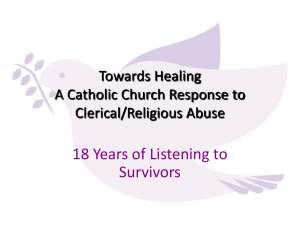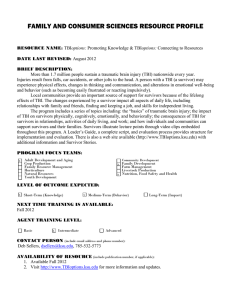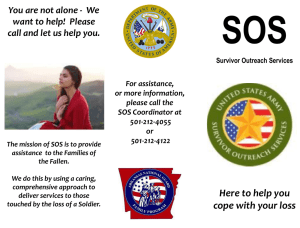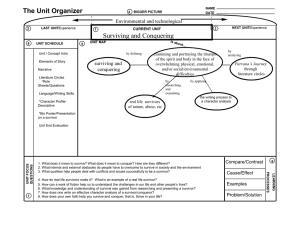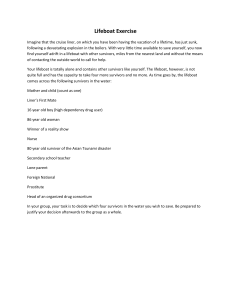Almost al l victim servic ce agencies h The goals
advertisement
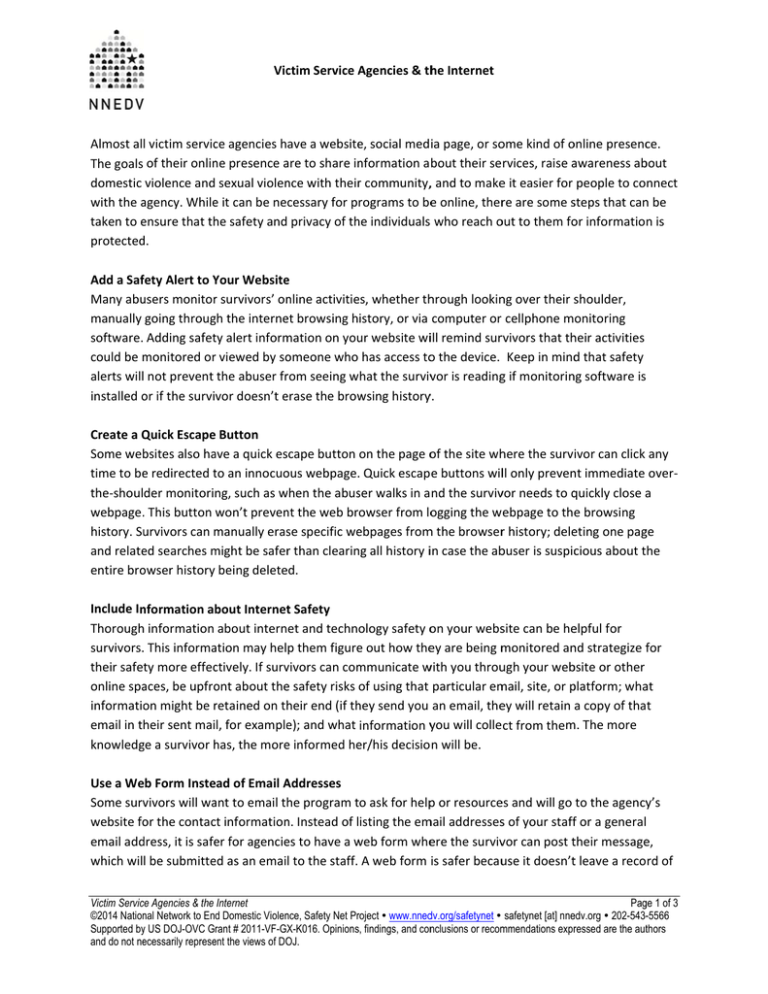
he Internet Vicctim Service A Agencies & th Almost all victim servicce agencies have a website e, social med ia page, or so ome kind of o online presencce. ne presence aare to share in nformation a bout their services, raise aawareness ab bout The goals of their onlin domestic violence and sexual violen nce with theirr community,, and to makee it easier for people to connect e it can be necessary for programs to bee online, therre are some ssteps that can n be with the aagency. While taken to e ensure that th he safety and privacy of th he individuals who reach o out to them fo or information is protected d. Add a Saffety Alert to Y Your Website e Many abu users monitorr survivors’ on nline activitie es, whether thhrough lookin ng over their shoulder, manually going througgh the interne et browsing history, or via computer or cellphone monitoring software. Adding safetty alert inform mation on you ur website wiill remind surrvivors that th heir activities could be m monitored orr viewed by so omeone who has access too the device. Keep in mind d that safety alerts will not prevent the abuser frrom seeing what the survivvor is readingg if monitorin ng software iss installed o or if the survivor doesn’t e erase the brow wsing historyy. Quick Escape e Button Create a Q Some web bsites also haave a quick esscape button on the page oof the site wh here the survivor can click any time to be e redirected tto an innocuo ous webpage.. Quick escap e buttons willl only preven nt immediate over‐ the‐shoulder monitoring, such as w when the abusser walks in a nd the survivvor needs to q quickly close aa nt the web browser from loogging the webpage to the browsing webpage.. This button won’t preven history. Su urvivors can m manually erasse specific we ebpages from m the browserr history; deleeting one pagge and relate ed searches m might be saferr than clearin ng all history iin case the ab buser is suspiccious about tthe entire bro owser history being delete ed. Include In nformation ab bout Internett Safety Thorough h information about internet and technology safety oon your webssite can be heelpful for survivors. This informaation may help them figure e out how theey are being m monitored an nd strategize ffor their safety more effecctively. If survvivors can com mmunicate w with you throu ugh your web bsite or other ont about the e safety risks of using that particular em mail, site, or p platform; whaat online spaaces, be upfro informatio on might be rretained on th heir end (if th hey send you an email, theey will retain a copy of that email in their sent mail, for example e); and what information yyou will collect from them m. The more has, the more e informed he er/his decisio n will be. knowledgge a survivor h eb Form Inste ead of Email A Addresses Use a We Some survvivors will waant to email the program to ask for helpp or resourcees and will go to the agencyy’s website fo or the contacct information n. Instead of listing the em mail addressess of your stafff or a general email add dress, it is safe er for agencie es to have a w web form wheere the survivvor can post ttheir messagee, which will be submitte ed as an email to the staff. A web form is safer becau use it doesn’tt leave a reco ord of Victim Servicce Agencies & the Internet Pagge 1 of 3 ©2014 Nationnal Network to End Domestic Violennce, Safety Net Prroject www.nneddv.org/safetynet safetynet [at] nneedv.org 202-543--5566 Supported byy US DOJ-OVC Grant # 2011-VF-GX X-K016. Opinionss, findings, and connclusions or recom mmendations exprressed are the autthors and do not neecessarily represeent the views of DO OJ. Vicctim Service A Agencies & th he Internet the email in the sender’s email sentt folder, which the abuser could find ou ut by going th hrough the uter with spyw ware, however, a survivor’ss email account. If the abussive individuaal is monitorinng the compu web form m will not concceal that a survivor has reaached out forr help. Web fo orms are also o more convenient because sstaff names and emails are en’t listed offe ering more prrivacy for stafff. For more information about safe em mail practicess with survivoors, see this handout. [Linkk to spyware handout.]] ation Online Limit Survvivor Informa Advocates and program ms should never share info ormation aboout survivors without the d direct permission of the surrvivor. Most p programs cannot share ide entifying inforrmation abou ut survivors w without an informed,, written, and d time‐limited d release. Eve en when prog rams are imp plementing so ocial media/o online campaign ns to raise awaareness abou ut domestic or sexual violeence, if survivvors informatiion is being shared, it should only b be done so w with their direct permissionn and followin ng federal and d state urvivors should be informe ed of exactly w what will be shared, who will potentiallly confidenttiality laws. Su see the in nformation, and possible consequencess of sharing thhis informatio on. nd privacy obbligations, visiit www.nnedv.org/tools. For more information on client conffidentiality an deos Posting Pictures & Vid ou post any pictures or vide eos online, be e sure to get informed con nsent from th hose in the Before yo pictures o or videos. If yo ou are hosting an event where you will be taking ph hotographs orr videos, allow w those present to opt out. They can choose to rem main out of frrame or you ccan have a deesignated areea for o don’t wish tto have their image posted d online. Donn’t forget thatt you should aalso get those who permissio on from staff, members of your board, p presenters, a nd speakers; do not assum me that becau use they workk for your age ency or was in nvited to speaak publically ffor you, that they are willing to have th heir images po osted online. ne Offering SServices Onlin Many pro ograms may b be tempted to o connect with survivors annd provide seervices througgh online spaaces, such as so ocial media, fo orums, or chaatting website es. Most of thhese websites are not buillt to offer seccure, private, and confidentiial conversatiions. Addition nally, using thhe internet to o communicatte adds anoth her layer of saafety risks and privacy plan nning that ad dvocates and survivors must think throu ugh. While it might be possible to co onnect with ssurvivors thro ough these sppaces, agenciees must thinkk through all tthe ne privacy con ncerns or posssible risks to prrivacy and saffety that mayy exist, which may include general onlin misuse byy the abuser. Victim Servicce Agencies & the Internet Pagge 2 of 3 ©2014 Nationnal Network to End Domestic Violennce, Safety Net Prroject www.nneddv.org/safetynet safetynet [at] nneedv.org 202-543--5566 Supported byy US DOJ-OVC Grant # 2011-VF-GX X-K016. Opinionss, findings, and connclusions or recom mmendations exprressed are the autthors and do not neecessarily represeent the views of DO OJ. Vicctim Service A Agencies & th he Internet Include A Accurate Inforrmation The intern net is global. If you have in nformation on nline that is sspecific to you ur area(countty, state, regio on) make thatt clear. Some laws and pro ocesses (such as orders of protections) or services (ssuch as state‐‐wide hotlines) aare state or ccounty specific. Survivors w who visit yourr site may be from across the country o or even world and should d be aware that some or alll of the infor mation provided might no ot be applicab ble to them. Age encies should d also list areaa codes with ttheir hotliness and phone n numbers as w well as office h hours so survivo ors know whe en to contact for help. Accessibillity Make you ur website mo ore accessible e for all viewe ers, including those with lo ow vision or w who are blind d or are Deaf C Check that im mages on yourr website havve alternativee text descripttions (html alt text). For lin nks, make sure e there is con ncise and desccriptive text w within each li nk (and withiin the html tittle tag) that describes where the lin nk takes a visitor. Doing so o will ensure tthat someonee who is acceessing your sitte or page via aa screen reader can listen tto helpful and d accurate infformation. If posting video o or audio, include captions o or transcripts so those who o are hard‐off‐hearing or D Deaf can also receive the in nformation. Victim Servicce Agencies & the Internet Pagge 3 of 3 ©2014 Nationnal Network to End Domestic Violennce, Safety Net Prroject www.nneddv.org/safetynet safetynet [at] nneedv.org 202-543--5566 Supported byy US DOJ-OVC Grant # 2011-VF-GX X-K016. Opinionss, findings, and connclusions or recom mmendations exprressed are the autthors and do not neecessarily represeent the views of DO OJ.
